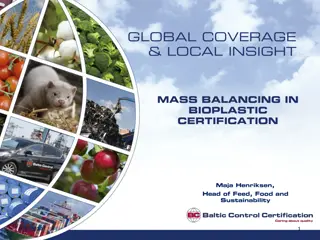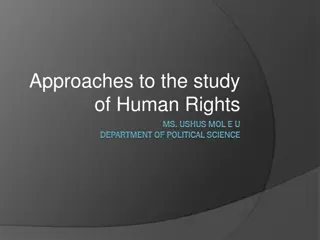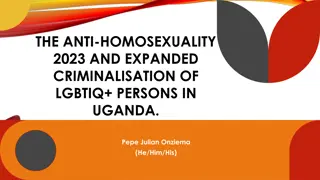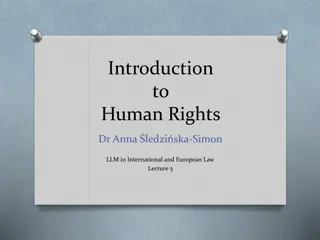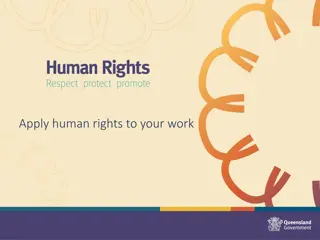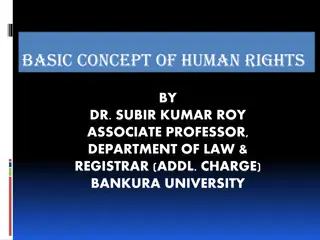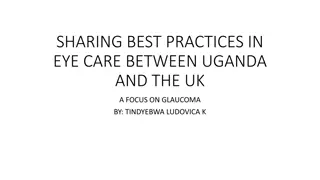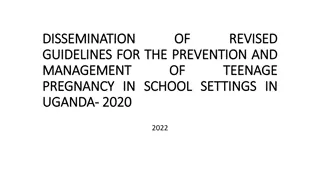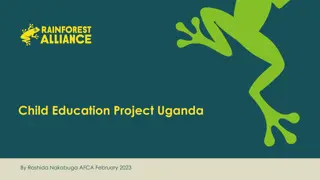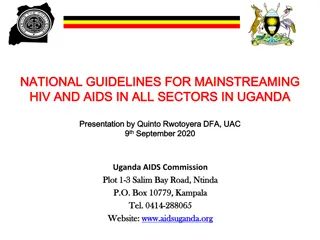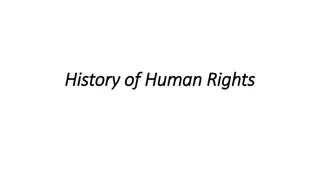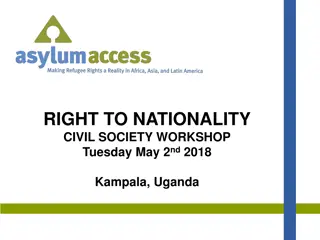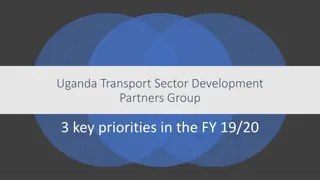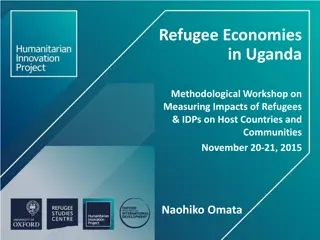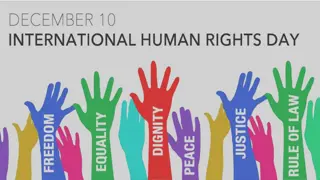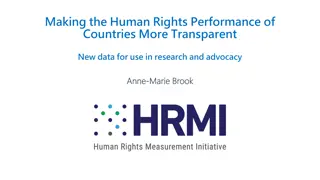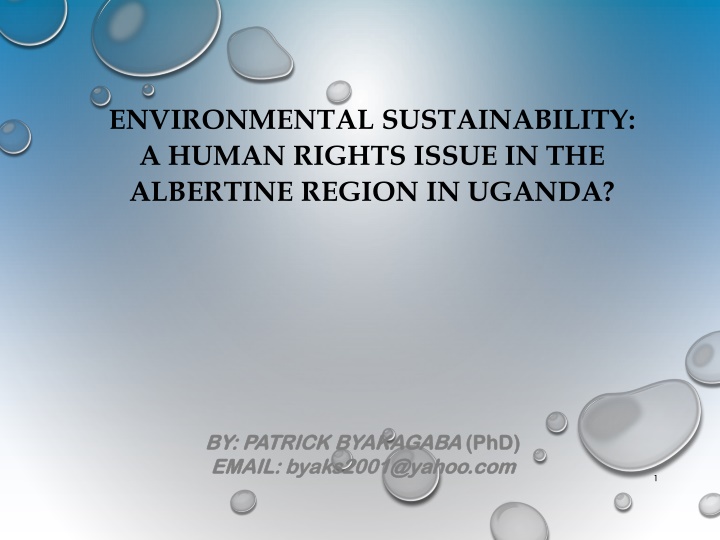
Environmental Sustainability and Human Rights: Impacts in Albertine Region, Uganda
ES became a global buzzword after the Brundtland report in 1987 highlighted threats to the planet and species. This article explores the discourse on environmental sustainability, focusing on the impacts of oil and gas exploration in the Albertine region of Uganda and the associated human rights issues. It discusses the need to assert specific human rights and provides recommendations for interventions promoting a human rights approach.
Download Presentation

Please find below an Image/Link to download the presentation.
The content on the website is provided AS IS for your information and personal use only. It may not be sold, licensed, or shared on other websites without obtaining consent from the author. If you encounter any issues during the download, it is possible that the publisher has removed the file from their server.
You are allowed to download the files provided on this website for personal or commercial use, subject to the condition that they are used lawfully. All files are the property of their respective owners.
The content on the website is provided AS IS for your information and personal use only. It may not be sold, licensed, or shared on other websites without obtaining consent from the author.
E N D
Presentation Transcript
ENVIRONMENTAL SUSTAINABILITY: A HUMAN RIGHTS ISSUE IN THE ALBERTINE REGION IN UGANDA? BY: PATRICK BY: PATRICK BYAKAGABA BYAKAGABA (PhD) EMAIL: EMAIL: byaks2001@yahoo.com byaks2001@yahoo.com (PhD) 1
OUTLINE Introduction Discourses on environmental sustainability Impacts of oil and gas exploration on environmental sustainability and the associated human rights Human rights that need to be asserted Recommendations on interventions that can promote invoking of human rights approach 2
INTRODUCTION ES became a buzzword globally after the Brundtland report was presented at press conference in London, 1987. Report observed that: Planet was at risk of being radically altered Lives of species including humans were at threat Drylands were turning into worthless deserts Forests were being destroyed at an unprecedented Burning of fossil fuel was increasing carbon dioxide Emissions from industries were threatening the ozone Agriculture and some industries were sources of toxic substances that polluted underground water aquifers. 3
INTRODUCTION It raised the idea of having shared perceptions of environmental issues and the appropriate efforts needed to deal with them It defined national and global discussions on environmental sustainability thereafter. Countries have increasingly found maintenance of important environmental functions as the hallmark of environmental sustainability since the report was presented Source function: capacity to supply resources Sink function: capacity to neutralize wastes without incurring ecosystem change or damage Life support function: capacity to sustain ecosystem health, integrity and functions N.B subject to various interpretations 4
INTRODUCTION ES focuses on ensuring balance, resilience and inter- connectedness that enable humans to satisfy their needs without exceeding the capacity of its supporting ecosystems to continue to regenerate the services necessary to meet those needs nor by their actions diminishing biological diversity It is about safeguarding life-support systems indefinitely and determining the quality and future of human existence This is most pervasive of all the global perspective on environmental sustainability 5
INTRODUCTION It is this interpretation that has been used to invoke human rights approach to attain environmental sustainability (determining human existence. It is considered an essential precondition for realization of human rights (inherent entitlements which come to every person as a consequence of being human) Human rights approach is promoted because it is perceived to secure higher standards of environmental sustainability based on the obligations of government to implement interventions to prevent and control activities that affect it Proponents argue that it ensures that governments are directly accountable for their failure to regulate and control environmental nuisances and enforcing environmental laws 6
INTRODUCTION Some critics find it too limiting because the environment should not be protected to serve interests and purposes of humans only but the intrinsic value should be considered too Human rights are a global standard which is difficult to set for environmental sustainability. Others contend that, using HR approach to ensure environmental sustainability is not fair because it places treatment of human beings and plants/animals on the same ethical plane Despite the reservations, UN human rights committee resolution 2005/60 recognized the link between human rights, environmental protection, and sustainable development 7
INTRODUCTION INTRODUCTION Principle 10 of the Rio declaration, seeks to ensure that every person has access to justice in environmental matters Article 24 of African (Banjul) charter on human and peoples' rights recognisesthe right of "all peoples" to a generally satisfactory environment favourable to their development. Principle 23 of the 1982 world charter for nature, provides that all persons shall have access to means of redress when their environment has suffered damage or degradation." Article 12 of the international covenant on economic, social and cultural rights recognizes individuals' right to health and provides that state parties will take steps to improve environmental and industrial hygiene 8
DISCOURSES ON ENVIRONMENTAL SUSTAINABILITY I present 4 levels of environmental sustainability provided by Goodland, (1995) whose characterisation is based on the extent to which functions of natural capital are substitutable to human-made capital Natural capital any stock of natural resources or environmental assetswhich provide a flow of useful goodsor services, now and in the future". This is for both human and non-human systems. The function of natural capital can be essential to the maintenance of natural capital itself, or maintenance of the goods and services provided by the natural capital 9
LEVELS OF ENVIRONMENTAL SUSTAINABILITY a)Weak environmental sustainability- implies that it is possible to convert all or most of the world s natural capital into human-made capital and still be as well off. b) Intermediate sustainability- patterns of development should not promote total decimation of one kind of capital no matter what is being accumulated in the other forms of capital. c) Strong environmental sustainability- it requires maintaining different kinds of capital intact separately. Natural and human-made capital are not perfect substitutes. Provides for complementarity between natural and man-made capital. 10
LEVELS OF ENVIRONMENTAL SUSTAINABILITY d)Absurdly strong environmental sustainability- provides for no depleting. Non-renewable resources-absurdly-should not be used at all. Renewables, only net annual growth increments could be harvested in the form of the over-mature portion of the stock. - To achieve ES countries can: concentrate on controlling pollution, ensure harvesting rates of renewable resources are below the regeneration rate, reduce their per capita consumption There are thresholds to the degree to which natural capital can be converted into man-made capital. 11
Impacts of Oil and Gas exploration activities on ES and the associated human rights in the Albertine region in Uganda Focus is impacts identified in Byakagaba et al. (2019) Air pollution due to dust and fumes from vehicles/machinery used in exploration Soil erosion due to clearing of vegetation during road/camp/pad construction Noise pollution due to blasting of rocks during exploration 12
Impacts of Oil and Gas exploration activities on ES and the associated human rights in the Albertine region in Uganda Rangeland loss due to infrastructure development Wetland loss due to infrastructure development and settlements Forest loss due to infrastructure development and settlements Encroachment of the wildlife conservation area by pastoralists due to loss of grazing areas to oil and gas exploration 13
HUMAN RIGHTS THAT CAN BE ASSERTED Legal standing or locus standi (a plaintiff must have a sufficient or personal stake in the outcome of a case, traceable to the defendant) is not a problem. Article 50 (2) of the constitution states that any person or organisation may bring an action against the violation of another person s or group s human rights . This implies that any individual or organization is allowed by law to protect the rights of another even though that individual is not suffering the injury complained of. 14
HUMAN RIGHTS THAT CAN BE ASSERTED It is possible to assert the right to a noise and air pollution free environment using the provision of a clean and healthy environment enshrined in Article 39 of Uganda's constitution. Protection of natural ecosystems especially wetlands and forests and protection of wildlife conservation areas can be asserted using article 237 (2) (b) which gives government to hold in trust for the people of Uganda these resources Sections 36, 45 and 47 of the National Environment Act provides for sustainable wetland, forest and rangeland management respectively 15
HUMAN RIGHTS THAT CAN BE ASSERTED Sections 27 and 28 provide for measures to address air and noise pollution. Section 67 provides for environmental restoration orders which could address issues related to soil erosion Section 44 of the Land Act provides for government or a local government holding in trust for the people and protect natural lakes, rivers, ground water, natural ponds, natural streams, wetlands, forest reserves, national parks Possible to file a suit claiming that there was breach of public trust doctrine by responsible bodies 16
CONCLUSION AND RECOMMENDATIONS ES can be achieved using a human rights approach in Uganda because of existing favourable legal framework Pursuing ES using HR requires a legal framework where environmental protection is regarded as a prerequisite to the exercise of fundamental human rights Asserting this right, require raising consciousness on the right to clean and healthy environment among judicial officers -by showing its context to economic, social and cultural rights so as to have adequate supportive jurisprudence 17
CONCLUSION AND RECOMMENDATIONS This requires as suggested by Burger, (2003) consideration for reinterpretation of existing rights to include environmental concerns e.g. polluting of drinking water and arable land may be interpreted as violating the right to life It may also be useful to enforce existing rights to achieve environmental sustainability through supporting local people to file environmental suits This can be through legal aid and improving governance systems of grass root community-based organisations 18
ACKNOWLEDGEMENT NORAD/ EnPe The PELIBIGO Team TUSEN TAKK, ASANTENI, AMESEGENALLO, GRACIAS, DHANYAVADA 19

